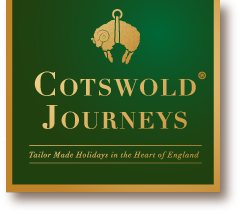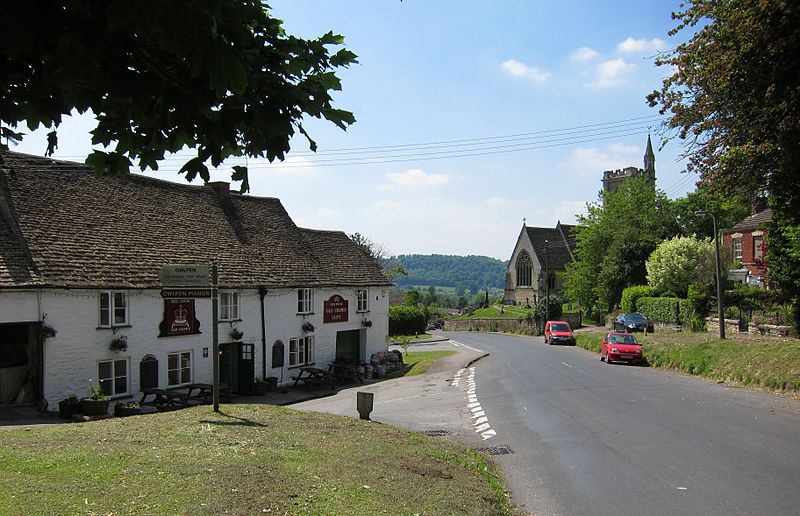Uley is one of many small and pretty villages in the southern part of the region, close to the Cotswold Edge. It is a place that you could easily pass through, but, remarkably, there are at least three good reasons to stop awhile.
Hetty Pegler’s Tump
A partly reconstructed Neolithic chambered mound, 37 metres (120 ft) long, atmospherically sited overlooking the Severn Valley. Hester, or ‘Hetty’ Pegler was its 17th century landowner. Between fifteen and twenty skeletons have been recovered from the mound over the years but we know little about the subsequent history of these finds. Two skulls went to Guy’s Hospital in London, but it is said that most of the bones were reburied in Uley churchyard. If you decide to visit Hetty Pegler’s you will need a torch or flashlight to examine the interior properly, and be warned that the interior can get muddy in wet weather.
Despite its apparently good condition, one of the best surviving of the Cotswold Severn group, Uley Barrow has suffered considerably from vandalism and casual excavation. Coins and pieces of broken pot found inside the barrow indicate that it was opened in Roman times. It was probably broken into again in the Middle Ages and damaged further in the 19th century.
The barrow as seen today is largely the result of the excavation and reconstruction undertaken by Dr John Thurnham in 1854 and subsequent repairs in 1871, 1891 and 1906. Although usually described as a long barrow, it is actually a transected gallery grave (a form of Megalithic tomb where there is no size difference between the burial chamber itself and the entrance passage. Two parallel walls of stone slabs were erected to form a corridor and covered with a line of capstones. The rectangular tomb was covered with a barrow or a cairn. Most were built during the fourth millennium BC, though some were still being built in the Bronze Age. This one was probably built before 3000 BC.). Its cruciform plan resembles that of a church with two pairs of chambers opening out of a central passage. The central passageway leads to an end chamber and two side chambers on the left or south side.
The north passage wall is a conjectural reconstruction but is known to have fronted two matching northern chambers, one of which was destroyed in 1821 by workmen who used the stone for their work. A modern pathway leads through the original forecourt area to the entrance, which is about one metre or three feet high and surmounted by a huge portal stone, an unusual feature that is probably the result of a passage capstone being wrongly replaced during the restorations of the 1800s. There would have been two further chambers in the north passage wall, but these were blocked off during excavation. It seems that the barrow was used regularly over a long period of time, the bones being disturbed, and perhaps removed occasionally for ritual use.
Uley Bury
To get to the top of this ancient fort from the village, walk from beside the pub on the main road through Uley. Cross the road and take the narrow footpath to the right of the church. Fork right before the first house and follow the path up towards the kissing gate. Enter the field and head for the edge of the woods to pick up the path towards the gate at the top. Enter the woods and continue straight uphill along the higher path to emerge at the foot of Uley Bury. Uley Bury is the long, flat-topped hill just outside and above the village. It is an impressive multi-vallate, Iron Age hill fort dating from around 300 B.C. Standing some 750 feet (235 metres) above sea level it commands spectacular views from the Cotswold escarpment over the Severn Vale. The Iron Age (characterised by the work of smiths who developed implements and weapons by hammering them into shape, rather than, as in the Bronze Age, casting them) is the third principal period of the three-age system created for classifying ancient societies and prehistoric stages of progress (the preceding ones being the Stone Age and the Bronze Age). It used to be thought that the Iron Age in Britain came about through invasion but it is now thought that the changes were effected more gradually through trade.
The earliest examples of hill-forts like the one at Uley date from the late Bronze Age and early Iron Age (900-600 BC). They show little evidence of permanent settlement and instead appear to have been used for seasonal gatherings, perhaps for trade or religious activities, and as a storage centre. By 450 BC, many were going out of use. Those that survived were rebuilt, often with multiple banks and ditches, various entrances and evidence of permanent population.
Uley hill fort was created by terracing a double line of ramparts – more than a mile in length overall – into the hillsides. Aerial photography has revealed extensive crop marks suggesting that there were once numerous dwellings in the interior of the hill fort. The most important of the three original entrances was probably the one on the north corner, where three sets of additional defences now destroyed by ploughing possibly provided an external complex entrance. The walk around its ramparts is flat, through woodland rich in Ash, Beech and Oak, carpeted with calcareous grasses and wildflowers. It was locally once known as the “maiden” hill since it was said never to have been captured and indeed so steep is the hill it is hard to imagine it being taken unless by surprise at the narrow neck that unites it with high land to the east. Another interpretation is that the name ‘maiden’ comes from Celtic words for ‘great hill’. Occupation seems to have ceased from 100 AD, by which time the Romans had conquered all of England.
Owlpen Manor (sometimes open to the public)
Owlpen Manor is a highly picturesque small manor house situated just outside the village. The current house dates from between 1450 and 1616 but there has been a house here since the 11th century, remaining in the same family until 1925, when it was purchased by Norman Jewson, the noted architect of the Arts & Crafts Movement from Sapperton, near Cirencester, who restored it with the help of local craftsmen and whose decorative flourishes – plasterwork birds, for example – are to be found throughout the house. The plan is typical of medieval English domestic informality, consisting of a 16th-century central hall, with wings added later. The three gables are each different from the other, which gives the house a curiously charming imbalance. On one side of the hall is the Oak Parlour, a Jacobean room furnished in styles from Tudor to the 20th century and with an oak floor by Jewson. On the other is the 18th-century Little Parlour. Above the hall is Queen Margaret’s Room, where Henry VI’s wife is supposed to have slept on the eve of the Battle of Tewkesbury (the final battle of the Wars of the Roses) and which is decorated with 17th or 18th century cloth hangings, canvas painted in water-based tempera and depicting the story of Joseph and the Coat of Many Colours. The garden is filled with the famous high yews that according to the writer Vita Sackville-West ‘make rooms in the garden with walls taller than any rooms in the house’.
The best view of the house is from the neighbouring fields across which conveniently runs a footpath.


0 Comments